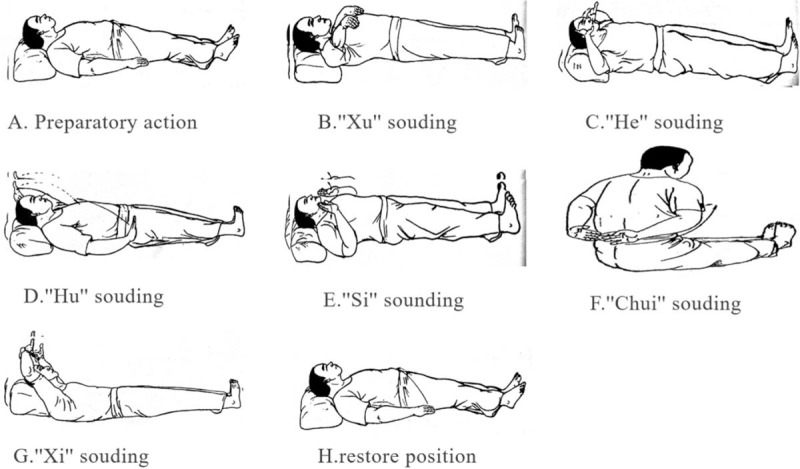Innovation
Patients with AECOPD benefited from liuzijue exercise for pulmonary rehabilitation, which also improved exercise tolerance, respiratory symptoms, and respiratory muscle fatigue.
Evaluation System
All individuals were receiving non-invasive breathing and their prescribed drugs. The CG got routine nursing care in accordance with the GOLD recommendations, which included medication, advice on quitting smoking, and life instructions. Based on routine nursing, the LG selected the Liuzijue, which involves lying and sitting, tcreated by the martial arts master, Mr. Ma Litang. LG worked out once in the morning and once in the evening for thirty minutes each during the three-month intervention.
Before starting the non-invasive breathing mask was removed and a nasal cannula was used to inhale low flow oxygen (2-4 l/min).
The target heart rate range for exercise intensity was 60–80% of maximal heart rate. The variations in fingertip oxygen saturation and heart rate were closely observed using a pulse oximeter. The patient's emotions were inquired.
The LG program included: (I) Warm-up: Patients adopted abdominal breathing to regulate breathing and gently stretched the limbs for 5 minutes; (II) Liuzijue exercise while sitting and lying down: Patients performed a complete Liuzijue while sitting and lying down for 20 minutes, including six different exhalation sounds (“Xu",” “He",” “Hu",” “Si",” “Cui",” “Xi“) and body activities; (III) Relaxation: patients regulated breathing and relaxed the body for 5 minutes.
Each patient lay while completing the Liuzijue exercise, which was performed under the supervision of respiratory physicians during hospitalisation. Before full discharge, patients and their families were ensured to have mastered the exercise techniques. After discharge from the hospital, Patients received weekly family visits and daily telephone counselling and monitoring. Patients were asked to record all aspects of their exercise programme, such as the number of repetitions, location and intensity.
Eighty-seven percent of AECOPD patients completed the nine-month study and were included in the analysis. The two groups were fairly equivalent at the start of the study and showed no discernible differences. There were also no significant differences (P>0.05) in general data, blood gas analysis, 6MWD, mMRC and SGRQ scores between the two groups (Table 1). Furthermore, according to the participants and the physician's observations, there were no unfavorable reactions during the intervention period.
Assessment
Sitting and lying Liuzijue exercise methods significantly improved lung function, exercise endurance, and quality of life in AECOPD patients with non-invasive ventilation. Sitting to lying Liuzijue exercise is a recommended rehabilitation modality for AECOPD patients with non-invasive ventilation, and this is a low-intensity aerobic exercise that can be done in bed without special equipment.
References
Liao, S., Wang, F., Lin, Q., Jian, F., Li, Y., Zhong, Q., Huang, Y., Lin, Y., & Wang, H. (2021). Effect of sitting and lying Liuzijue exercise for pulmonary rehabilitation in acute exacerbation of chronic obstructive pulmonary disease patients with non-invasive ventilation: a randomized controlled trial. Annals of palliative medicine, 10(9), 9914–9926.
doi.org/10.21037/apm-21-2157" target="_blank">doi.org/10.21037/apm-21-2157








